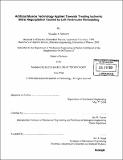| dc.contributor.advisor | Ian W. Hunter. | en_US |
| dc.contributor.author | Sabourin, Nicaulas A. (Nicaulas Alexandre), 1978- | en_US |
| dc.contributor.other | Massachusetts Institute of Technology. Dept. of Mechanical Engineering. | en_US |
| dc.date.accessioned | 2005-09-06T21:49:41Z | |
| dc.date.available | 2005-09-06T21:49:41Z | |
| dc.date.copyright | 2004 | en_US |
| dc.date.issued | 2004 | en_US |
| dc.identifier.uri | http://hdl.handle.net/1721.1/27117 | |
| dc.description | Thesis (S.M.)--Massachusetts Institute of Technology, Dept. of Mechanical Engineering, 2004. | en_US |
| dc.description | Includes bibliographical references (leaves 89-91). | en_US |
| dc.description.abstract | Ischemic Mitral Regurgitation (MR) affects a large portion of patients suffering from ischemic heart disease. Significant MR develops in one quarter to one third of patients who suffer from ischemic heart disease and doubles their late mortality rate after a myocardial infarction or revascularization. MR is most often caused by the bulging, or remodeling, of the heart's left ventricle. This remodeling displaces the papillary muscles inside of the ventricle and tethers the mitral valve, preventing it from closing properly. Current treatments attempt to either repair or replace the valve. These treatments require the heart be stopped and the patient be placed on a cardiopulmonary bypass pump for many hours. Both treatment approaches have serious side-effects, including relapse of the MR as quickly as six months post-operatively. This thesis concerns the development of an active artificial muscle patch (AMP) for application to the exterior of the heart. The AMP constructively remodels the heart in order to alleviate MR. Two in-vivo experiments were conducted with a heart-gated fluid pumping apparatus connected to a balloon patch that successfully proofed the concept that an active patch can relieve MR. These experiments also established data on the mechanical requirements of such a patch. An in-vitro heart model was created to test iterations of AMP devices before undergoing further in-vivo studies. Development of an AMP using Nickel-Titanium shape memory alloy was begun and iterations of this device have had early success in in-vitro tests. | en_US |
| dc.description.statementofresponsibility | by Nicaulas A. Sabourin. | en_US |
| dc.format.extent | 115 leaves | en_US |
| dc.format.extent | 5534285 bytes | |
| dc.format.extent | 5548089 bytes | |
| dc.format.mimetype | application/pdf | |
| dc.format.mimetype | application/pdf | |
| dc.language.iso | en_US | |
| dc.publisher | Massachusetts Institute of Technology | en_US |
| dc.rights | M.I.T. theses are protected by copyright. They may be viewed from this source for any purpose, but reproduction or distribution in any format is prohibited without written permission. See provided URL for inquiries about permission. | en_US |
| dc.rights.uri | http://dspace.mit.edu/handle/1721.1/7582 | |
| dc.subject | Mechanical Engineering. | en_US |
| dc.title | Artificial muscle technology applied towards treating ischemic mitral regurgitation caused by left ventricular remodeling | en_US |
| dc.type | Thesis | en_US |
| dc.description.degree | S.M. | en_US |
| dc.contributor.department | Massachusetts Institute of Technology. Department of Mechanical Engineering | |
| dc.identifier.oclc | 56842544 | en_US |
